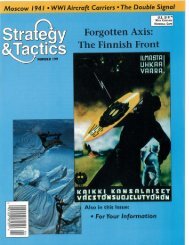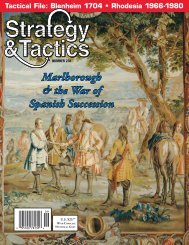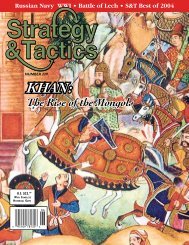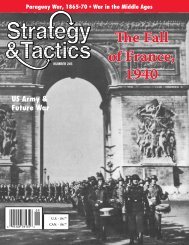COUNTERSTROKE AT SOLTSY - Strategy & Tactics Press
COUNTERSTROKE AT SOLTSY - Strategy & Tactics Press
COUNTERSTROKE AT SOLTSY - Strategy & Tactics Press
You also want an ePaper? Increase the reach of your titles
YUMPU automatically turns print PDFs into web optimized ePapers that Google loves.
60 #232<br />
mount their famous counterattack at Belleau Wood. A month<br />
later, a combined US and French force mounted a smashing<br />
attack on the German salient which still threatened Paris. In<br />
three bloody weeks the Allies reduced the salient, drew off<br />
Ludendorf’s reserves (until then earmarked for yet another<br />
German offensive in Flanders) and permanently wrested the<br />
strategic initiative from the Imperial German Army. This<br />
game would simulate these summer battles along the Marne<br />
at the regiment and brigade level, employing a variation of<br />
the Lost Battalions game system. Ty Bomba.<br />
D4. Plan 1919. Based on the premise World War I lasted another<br />
year, using the Reinforce the Right system. The game<br />
would include Gen. Fuller’s planned tank corps, strategic<br />
bombing, railroad guns and even an Allied parachute division.<br />
The Germans would also have elite Freikorps units that<br />
can use storm tactics. Units would be corps, with divisional<br />
breakdowns. American reinforcements for the Allies would<br />
be critical, including US Marine Corps amphibious assaults.<br />
There would also be an option for German tank fleets, which<br />
will allow for mass tank-versus-tank battles. The map will<br />
cover the Western Front from Paris to the Ruhr. Joseph Miranda.<br />
D5. Soldiers 2: Mobile Tactical Combat in Europe, 1918.<br />
An update of the SPI classic that covered the pre-trench warfare<br />
of 1914-15. Scenarios would include historic and whatif<br />
episodes from the western front, 21 March-11 November<br />
1918. The system would be kept simple, but expanded to<br />
cover heavy artillery, CW, air support, tanks, and infiltration<br />
tactics. Ty Bomba.<br />
D6. Operation Gericht—The Battle of Verdun, 1916. Turns<br />
equal one week and are of two types: attrition, in which the<br />
effects of a week’s shelling and contact are abstracted; and<br />
assault, broken into daily impulses of fluid movement and<br />
higher losses of major offensives. Artillery will be crucial.<br />
Rules for pioneers, Brandenburgers, Moroccans, territorials,<br />
melee, fortress reduction, isolation, morale, linear attack and<br />
morale are included. Units represent infantry battalions and<br />
regiments; artillery is designated abstractly by type. Large<br />
hex map with small counters. Ty Bomba.<br />
World War ii (circa 1930 to 1945 a.D.; mark<br />
1 to 6)<br />
E1. Barbarossa, 3rd ed. Army-level (with some corps) units<br />
are used on both sides to allow to players to game WWII’s<br />
entire eastern front, from Barbarossa to Berlin, in single evening.<br />
One map, one counter sheet. Ty Bomba.<br />
E2. Ty Bomba’s Kursk. The 1971 SPI flatbox edition of<br />
Kursk battle game was redesigned, in a mechanically overdone<br />
way, in 1979, as “Eric Goldberg’s Kursk.” This edition<br />
would return it to a simpler level using a derivation of the<br />
recent Drive on Stalingrad system, concentrate play on the<br />
July scenario, while also allowing for Manstein’s options of<br />
maximum reinforcements taken from all other fronts and attacking<br />
the western face of the salient. Ty Bomba.<br />
E3. Strike North: Japan Attacks the USSR. One of the<br />
great “what-ifs” of World War II, a hypothetical Japanese<br />
invasion of the Soviet Union in 1941. The assumption is the<br />
Japanese decide to forego their offensive in the Pacific and<br />
instead invade the USSR to support the Third Reich. Units<br />
will be divisional and corps level, including air units. There<br />
will be different CRTs demonstrating Japanese and Soviet<br />
tactics. Joseph Miranda.<br />
E4. USAAF. An update/remake of Flying Fortress, origi-<br />
nally offered to Avalon Hill by the early SPI-crew. This<br />
game takes an operational/strategic, effects-based approach<br />
to modeling air operations in 1944, the decisive year in the<br />
air war over Hitler’s Europe. There would be two 1944 scenarios,<br />
one covering just US daylight efforts and a second,<br />
“Grand Campaign Game,” that would also include RAF<br />
night bombing. There will also be a one-month “mission<br />
game,” covering the destruction of the Luftwaffe fighterarm<br />
in March. Chrome would include: a full German FLAK<br />
order of battle, airfield strafing, variable German aircraft<br />
production (including exotic jet and rocket planes, with<br />
the player being able to choose where to put the emphasis),<br />
FLAK busting, P-47 drop tank problems, variable “critical”<br />
German industrial sectors, plus all kinds of optional aircraft<br />
to see the effects of faster R&D efforts on both sides. Additional<br />
scenarios will include the 1943 strategic bombing<br />
campaign, the pre-Overlord campaign, and alternative campaigns.<br />
Bomba/Miranda.<br />
E5. Salerno. The Victory in the West system moves on from<br />
Sicily (S&T#89) to the landings on the mainland. Nathan<br />
Kilgore.<br />
E6. Rhineland. What if Britain and France confronted<br />
Hitler when he reoccupied the Rhineland and did not back<br />
down? World War II breaks out in 1936. Both sides would be<br />
woefully unprepared, but there would have been some real<br />
potential for a Spanish Civil War style conflict in which the<br />
emerging military systems of armor and airpower would be<br />
employed. There would also be the chance for Soviet and<br />
US intervention. The game map would cover western and<br />
central Europe. Units would be divisions and corps, as well<br />
as airpower. Joseph Miranda.<br />
modern (circa 1946 to present; mark 1 to 3)<br />
F1. Air War 73. This would be a simulation of the 1973<br />
Arab-Israeli air war. Units would be squadron level, differentiated<br />
by aircraft type. The system would emphasize<br />
command control, electronic warfare, suppression of air defenses,<br />
and logistical planning. Players would have to trade<br />
off aircraft losses versus requirements of the ground war.<br />
Joseph Miranda.<br />
F2. Angola. This will be a strategic-level game of the Angolan<br />
civil war of 1976-1990s, using the S&T Holy War:<br />
Afghanistan system. During the Cold War, Angola became<br />
a major battleground of East versus West, which eventually<br />
developed into some major mechanized clashes. Forces will<br />
include the MPLA, Unita, FNLA, Cubans, South Africans,<br />
and CIA mercenaries, as well as possible UN and Organization<br />
of African Unity intervention forces. Units will be brigade-division<br />
level, with some special operations battalions.<br />
Units will be rated for their conventional military capability<br />
and their insurgency value. The political aspect of the war<br />
will be simulated via a chit picking system that will mobilize<br />
various forces and allow for the vicissitudes of international<br />
intervention. Turns will be yearly. The game will include<br />
several short scenarios as well as one grand campaign of the<br />
entire war. Joseph Miranda.<br />
F3. Cold War Battles II. This would include two games<br />
from the following: Pentomic (Soviet combined arms army<br />
versus US divisions in 1960 Germany, with plenty of tactical<br />
nukes);Kabul Strike (the initial Soviet intervention in<br />
Afghanistan, which saw airborne, Spetsnaz and mechanized<br />
forces seize control of the capital); Congo (mercenaries versus<br />
rebels in the 1960s); Sandinista (Nicaragua 1979, the final<br />
rebel offensive against Somoza’s National Guard). Game







